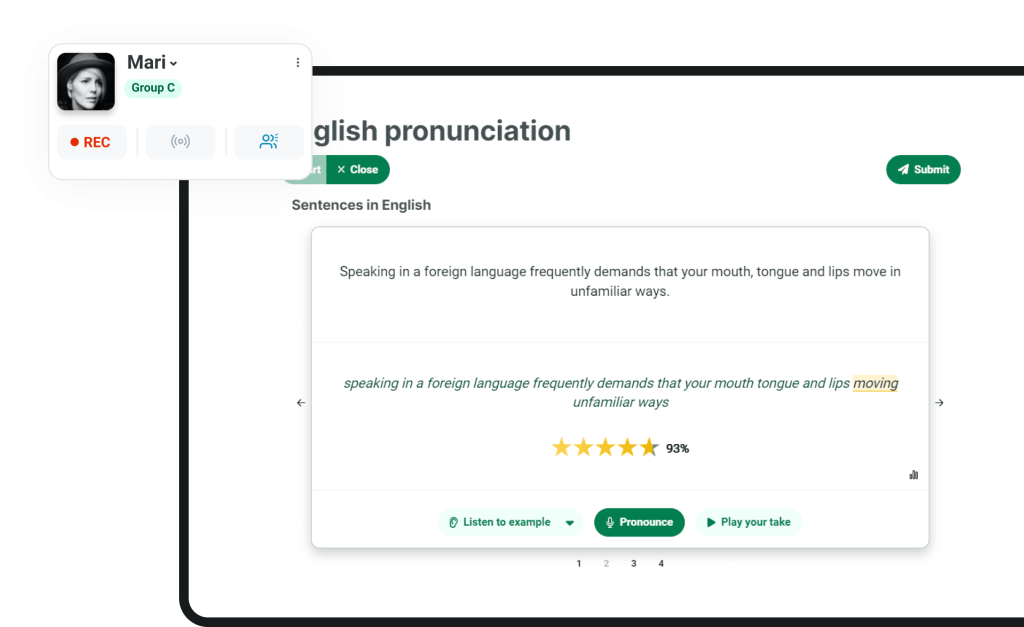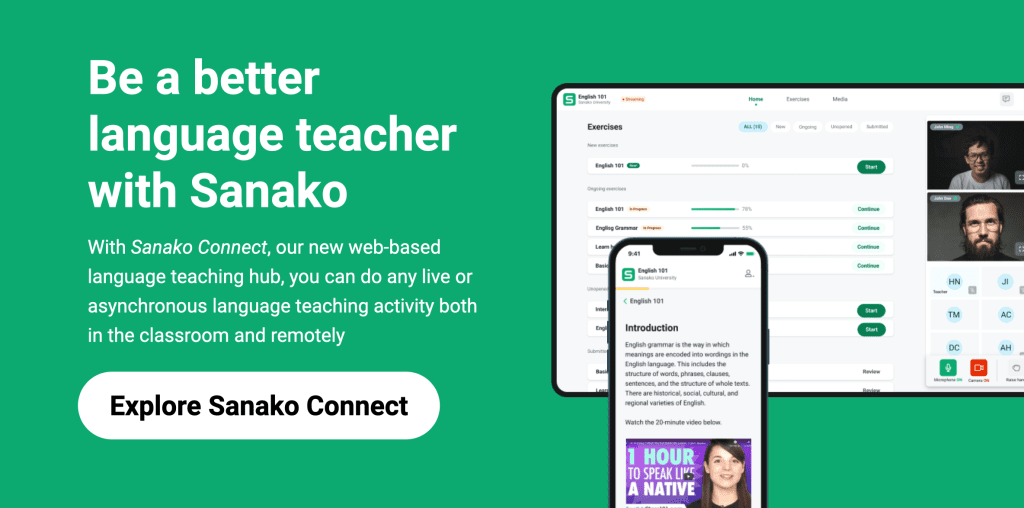This is a reposted and updated version of our old blog post on the Comprehensible Input (CI) language teaching approach. Our refreshed article now includes a wealth of additional resources and an expanded theory section, providing even more valuable insights for our blog readers. The original blog post was published on September 29, 2021 and was last updated on October 5, 2023.
The concept of Comprehensible Input (CI) derives from Stephen Krashen’s hypothesis on second language acquisition. Activities based on CI require students to actively gain an understanding of the teacher’s instruction and of the context in which the targeted language is being used. Therefore, CI provides a practical instrument to guide students towards a natural acquisition of a new language regardless if their target language is English, Spanish, German, French or any other language for that matter. In this article, we will explore the benefits of incorporating CI in your language classes.
Language acquisition vs. learning: the foundation of the Comprehensible Input approach
The concept of Comprehensible Input was developed by linguist Stephen Krashens after years of studying the process of language acquisition in children. In his Theory of Second Language Acquisition, Dr. Krashen identifies two paths to second language performance. The first path is called language acquisition, the second one is that of language learning. What sets them apart?
Language acquisition, according to Krashen, is a process that occurs at the unconscious level, through constant exposure to a language. Acquisition is what occurs in children when they learn to speak their native language. Children’s attention is focused on understanding the messages they receive from outside and communicating with their surroundings. Language learning, on the other hand, is what happens within a regulated and, in a certain sense, artificial context such as a language course.
To Krashen, the most effective route to learning a second language is through language acquisition. The key point of Krashen’s theory is that becoming fluent requires concrete and constant interaction with the target language. The conclusion of this approach, then, is that we acquire literacy when we become able to understand and transmit messages.
Krashen’s five hypotheses making up the Comprehensible Input theory
These five hypotheses are foundational to Krashen’s theory of second language acquisition and have had a significant influence on language teaching and learning since. The hypotheses are:
-
The Input Hypothesis: This hypothesis suggests that new language learners acquire the target language best when they are exposed to input that is slightly beyond their current level of proficiency but still comprehensible. Krashen argues that learners need to understand the language they are exposed to (this is where the term “comprehensible input” comes from) in order to acquire it.
-
The Monitor Hypothesis: This hypothesis suggests, as explained in the previous chapter above, that there are two ways of using language: acquisition and learning. “Acquisition” refers to the subconscious, natural process of internalizing language through exposure, while “learning” involves conscious, rule-based knowledge of grammar and vocabulary. Krashen argues that the acquired system is responsible for most language production in real-time communication, whereas the learned system functions as a monitor or editor. In other words, this hypothesis suggests that while conscious learning and rule-based knowledge of language can play a role in language production, they are not as effective or efficient as the acquired system, which is developed through exposure to comprehensible input and natural language use.
-
The Natural Order Hypothesis: This hypothesis proposes that there is a natural and predictable order in which learners acquire the grammatical structures of a language. Krashen suggests that this order is largely unaffected by explicit instruction or error correction.
-
The Affective Filter Hypothesis: This hypothesis proposes that affective factors, such as motivation, anxiety, and self-confidence, can either facilitate or impede language acquisition. When learners are in a positive emotional state, their “affective filter” is low, allowing them to better absorb and acquire language. Conversely, a high affective filter, often due to negative emotions or anxiety, can hinder language acquisition.
-
The Acquisition-Learning Hypothesis: This hypothesis is very much linked to the Monitor Hypothesis and distinguishes similarly between two ways of gaining language proficiency: language acquisition (a subconscious, natural process) and language learning (conscious, rule-based study). It suggests that language acquisition is the more effective and essential of the two processes for real communication. Language acquired through immersion in comprehensible input is more readily available for spontaneous use.
These five hypotheses collectively form the foundation of Krashen’s theory of second language acquisition. They have influenced language teaching methodologies, advocating for the importance of meaningful communication, comprehensible input, and creating a positive affective environment in language classrooms.
According to Krashen, learning a second language can be a natural process on par with learning the first language basically replicating the way native speakers learn their own language.
For this to be possible, however, the student should be exposed to compelling and meaningful content that prompts him or her to continuously interact with the targeted language. This content is defined by Krashen as Comprehensible Input.

In the above video, Dr. Krashen explains the core concepts of the Input Hypothesis. Comprehensible input is the language that learners can understand without recognizing all the grammar rules in it. For it to be effective, the impulse should be just one level above the student’s level of proficiency. It is, therefore, possible to summarize the Input Hypothesis as it has been done here:
“[…] Language learners improve in a language when they are given language input that is slightly more advanced than their current level. Krashen called this “i + 1” where “i” is a person’s current language level and “+1” represents language that is slightly more advanced than their current level.”
Is the Comprehensible Input approach an effective language teaching method?
From a purely academic point of view, there is no clear consensus about the effectiveness of the Comprehensible Input approach. Some have criticized Krashen’s theory, arguing that it is possible to achieve excellent levels of fluency even in traditional classroom teaching contexts.
On the other hand, some studies have experimentally tested the Comprehensible Input approach, obtaining results that seem to confirm the validity and effectiveness of this method.
As we have stated several times, each language teaching method has its strengths and each method can be the right one if it meets the needs and inclinations of the students.
The Comprehensible Input approach certainly has strengths for those who want to encourage students to interact more in the second language but without forcing them into traditional classroom exercises that often fail to stimulate the curiosity of students.
As we will see in the following section, a classroom-based on the Comprehensible Input approach is highly interactive and entertaining.
The Comprehensible Input approach requires the active involvement of students and is most effective when supported by the use of multimedia language learning content. Therefore, using this method will allow you to introduce different study materials (books, movies, podcasts) naturally into the language classroom, providing students with interactive and stimulating learning materials.
Finally, there is another advantage of this approach to consider: it can be practiced anywhere without spending too much.
If you are having difficulty engaging students to participate in classroom activities or if you notice that your students struggle to actively use the targeted language, the following sections on the implementation of Comprehensible Input strategies may give you some ideas on how to make things better.
Comprehensible Input strategies for language teachers
The first step in preparing lesson plans based on the Comprehensible Input approach is to determine the language ability level of the students — always remember the “i +1” formula!
Krashen himself identifies four strategies depending on the level of students’ proficiency:
- Direct Instruction: this is an approach to use during the early steps of the language acquisition process. In this case, it is the teacher who instructs the students on what to do. It is very important at this stage to put the words and phrases in context to help students understand. As it has been noted, “appropriate context is crucial” and providing instructions based on experiences that are relatable to the students is a powerful way to aid their understanding.
- Joint Construction: this strategy is appropriate for students with a basic language understanding. In this case, students can interact more with the teacher, and carry out instructions on their own. The teacher’s guiding role, however, must always be present.
- Coached Construction: in this case, students enjoy a significant level of autonomy. The teacher no longer guides the progress of activities but observes students acting individually, intervening only if necessary. In this phase, it is possible to start exploiting multimedia content to help students develop a greater understanding of targeted language.
- Monitoring: In this phase the autonomy of the students is maximum, and constant supervision by the teacher is no longer necessary.
Below are some additional facts and nuances to consider if you are interested in trying out the CI approach in your language classroom:
-
Keep emphasis on listening and reading tasks: CI places a significant emphasis on listening and reading as the primary ways to acquire a language. These activities are believed to provide the necessary input for language development before leaners are able to produce spoken language.
-
Minimal error correction: CI practitioners generally avoid heavy error correction during the learning process. Instead, they focus on providing a supportive and low-stress environment where learners can make mistakes and learn from them naturally.
-
Sheltered instruction: In CI classrooms, teachers often “shelter” vocabulary and grammar, meaning they introduce new words and language features in a gradual and scaffolded manner, starting with core vocabulary lists and structures.
-
Respect the silent period: CI acknowledges that learners may go through a “silent period” where they are absorbing language input without actively producing much output. This stage is seen as a normal part of language acquisition.
-
Fluency over accuracy: CI tends to prioritize communicative fluency over perfect grammar and accuracy, believing that accuracy will improve over time with increased exposure to comprehensible input.
Bringing the Comprehensible Input approach in the classroom with Sanako Connect
A central assumption of the Comprehensible Input approach is that the input must be comprehensible but also compelling. Therefore, it is important to use language learning content that not only aids understanding of the input but also provides the stimulus for students to discuss the topics of the lesson.
The best way to keep student engagement high is to vary the source of input. That’s why using multimedia content is a great way to convey consistent language and at the same time create opportunities for discussion.
The resources that a teacher has available in this case are endless: presentations, infographics, specialized reading, songs and podcasts, Youtube videos, games and apps, etc. The important thing is that they are level-appropriate and that they help students understand and convey meaningful concepts.
Sanako Connect is a software tool for language educators to deploy interactive language teaching strategies based on multimedia learning content. This browser-based software allows teachers to create their own educational materials and easily share them with students.
Educators can use Sanako Connect’s content creation features to add energy to their lesson, exploiting the power of visuals to broaden students’ understanding of new concepts. Connect also empowers teachers to set up speaking and pronunciation exercises for students that can be carried out either individually or in groups. Therefore, it is possible to have students read a text or watch a film and then open a discussion to test students’ understanding. This approach allows for the consistent development of reading, listening, and speaking skills as part of comprehensible input.
Sanako Connect is designed to provide students adequate time to actively practice core language skills. Therefore, it provides the necessary inputs to help students acquire a foreign language naturally.
If you would like to find out more about how Sanako Connect can enable language educators to deliver more impactful, interactive language teaching strategies, then click below to learn more and to book a FREE remote demo.



